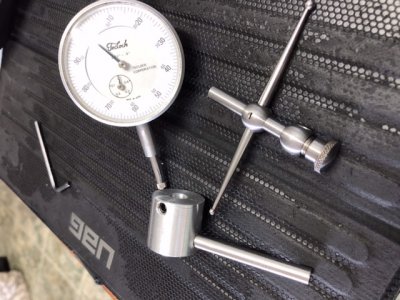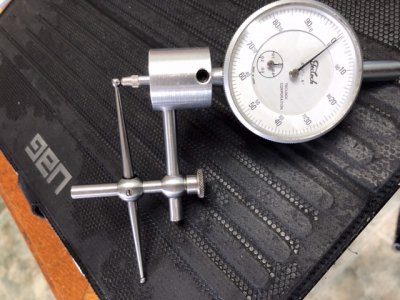- Joined
- Jul 16, 2020
- Messages
- 29
This has probable done to death but here goes.
Well I have looked for a inside indicator for a while and the only one with any reach seems to be the starret made for the old back knob indicator.
What happened ?
30-40 yrs ago their were plenty around at least where I did my time.
Any way I had a look on the interweb and only found one hit that anyone had made.
There seemed to some math involved and precise mill drilling to make it work.
Here’s my take on it.
found a bit of aluminium 1" round bar about that long.
Measured the dail indicators barrell?
Drilled the hole out . Mine was easy 0.312"
stuck it on the indicator and figured I’d have a little wiggly room up and down for adjustments.
Drill and tapped it for a grub screw. May make a knurled thumb screw one of these days.
Machined down some s/s rod I had that has never rusted.
And yes it squealed in protest all the way machining to a few tenths under the 0.250" indicator attachment hole.
proceeded to drill a 1/4 inch hole in the dail Indicator holder piece using the tool post to hold it square.
Then used a bit of Loctite to fix it in situ.
Ohhh hell everyone confused?
here is a few pics.


Easy enough to align on the centre of the ball of The indicator where you want it.
Simple really.
I suppose there could be some errors of measurement but good enough for indicating internal bores true.
Now just have to figure how to put my tenths indicator on it with that little arm they have.
Hope it helps someone.
Bruce.
Well I have looked for a inside indicator for a while and the only one with any reach seems to be the starret made for the old back knob indicator.
What happened ?
30-40 yrs ago their were plenty around at least where I did my time.
Any way I had a look on the interweb and only found one hit that anyone had made.
There seemed to some math involved and precise mill drilling to make it work.
Here’s my take on it.
found a bit of aluminium 1" round bar about that long.
Measured the dail indicators barrell?
Drilled the hole out . Mine was easy 0.312"
stuck it on the indicator and figured I’d have a little wiggly room up and down for adjustments.
Drill and tapped it for a grub screw. May make a knurled thumb screw one of these days.
Machined down some s/s rod I had that has never rusted.
And yes it squealed in protest all the way machining to a few tenths under the 0.250" indicator attachment hole.
proceeded to drill a 1/4 inch hole in the dail Indicator holder piece using the tool post to hold it square.
Then used a bit of Loctite to fix it in situ.
Ohhh hell everyone confused?
here is a few pics.


Easy enough to align on the centre of the ball of The indicator where you want it.
Simple really.
I suppose there could be some errors of measurement but good enough for indicating internal bores true.
Now just have to figure how to put my tenths indicator on it with that little arm they have.
Hope it helps someone.
Bruce.
